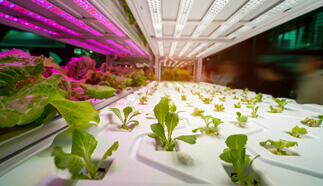<< View SCS Blog
Conformal Coating for Agricultural Lighting

Used for food production, indoor gardening and hydroponics and horticulture, grow lights have both industrial and consumer applications. Because total illumination intensity diminishes with distance from the point source (grow lightbulbs), production efficiency is enhanced by:
- Close placement of lights to plants
- Use of reflectors within the growth environment to shine light back onto plants
- Close arrangement of plants to maximize special growth capacities
The objective is equal lighting, with the entire range of generated illumination shining on plants. Where direct light is impossible, indirect light is provided by reflectors. Space surrounding plants is never a target of grow lighting.
Essential grow light bulb types include fluorescent, incandescent, high intensity discharge (HID). high pressure sodium (HPS), light emitting diode (LED) and metal halide (MH) lamps. Plants respond differently to different kinds of light, so the type of grow lighting required for optimal performance is always based on the varieties of flowers/vegetables being grown. While fluorescents and MH have been the most commonly used grow light solutions, LEDs are becoming more prominent due to their lower cost and productive efficiency. For enhanced performance, relatively high-power, LED grow lights can have built-in cooling systems; lowering temperature improves both their brightness and longevity.
For optimal efficiency, grow lights need to operate for extended durations of time, causing generation of higher-level heat as well as moisture and humidity. Although LED grow lights are designed to provide as many as 75,000-90,000 hours of illumination under laboratory conditions, their performance diminishes when subjected to persistent real-world, real-time usage. Sensitive to heat and humidity/moisture, LEDs and other grow light solutions require protection to operate near maximum efficiency. Conformal coatings protect bulbs and electronics from these intrusive conditions.
Heat and humidity are major, co-aligned characteristics of many grow light environments. Both silicone resin (SR) and Parylene (XY) offer good grow light protection.
Silicone resists moisture extremely well. SR’s key advantage providing conformal film protection stems from the relatively thick coating layer – as much as 0.01 inch in some cases — required for effective use. This property significantly reduces the likelihood of surface pinholes, a source of humidity incursion within the bulb, leading to dysfunction. SR thickness also defensively pads the grow light’s surface, sustaining its structural integrity. Silicone’s major performance issue – poor abrasion resistance – is less of a problem in often restricted grow-light settings, where physical interaction with the bulb is minimal. Except for occasional re-positioning, bulbs are generally only touched during removal; plants don’t actively interact with grow lights, diminishing the incidence of potential abrasive events. Silicone conformal coating meets most high-heat requirements for LED and other grow lights. Some specially manufactured SR coatings offer protection beyond 200ºC. Parylene offers a good alternative for high humidity grow-light environments. Its ultra-thin coating provides moisture and humidity protection at layer thicknesses as little as 1/100th of SR’s normal deposition levels.
Moreover, Parylene’s unique chemical vapor deposition (CVD) process applies the polymer as a gas, which seeps into the surface of grow light substrates, and settles above; the result is a truly conformal, pinhole-free film humidity and moisture cannot penetrate. Micron-level coating layers do not measurably increase the grow light’s size, encouraging use in more confined growing regions. Harder than SR, Parylene withstands abrasion far more effectively. In addition, clear coating surfaces do not interfere with the intended performance effects of colored bulbs (LED, MH, etc.), which can enhance plant fertility/production; in this respect Parylene’s clear films are exceptionally valuable simultaneously protecting and enhancing the performance of combined red/blue/green grow lighting for accelerated plant growth. Parylene is an excellent choice for grow light LEDs typically used in higher heat/humidity environments.

